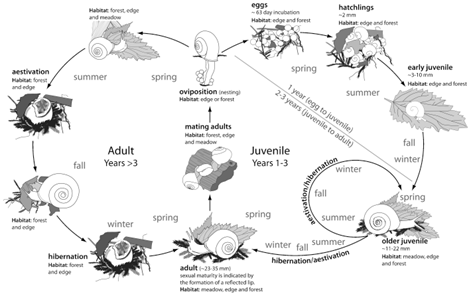
Life Cycle
Snails of the genus Allogona have been observed to be sexually active in the period of time from April to June, with eggs and juveniles appearing from May to July. This seasonal timeframe is linked to moisture availability (Steensma, 2009).
After fertilization, members of A. townsendiana have been observed to begin digging nesting holes with their foot. They then lay eggs in the nest before burying it. Nests are typically the length of the entire snail (~6-10 cm) (Steensma, 2009).
Juveniles typically hatch 8-9 weeks after eggs are deposited in the nests. Hatchlings observed at nest sites were ~2 mm and grow to 5 mm by the 2nd month (Steensma, 2009). Then the juveniles are thought to take 2-3 years to reach sexual maturity, however there is little information on the late juvenile stages (Steensma, 2009).
Highest levels of activity were observed from April-June, with summer activity decreasing later in the season. Snails undergo periods of aestivation to reduce water loss when temperatures are too high or moisture levels are low. This often occurs in the warmer months of July and August (Steensma, 2009). Snails secrete an epiphragm of dried mucus to seal the aperture of the shell against desiccation.
Species of snails in the Allogona genus have been observed to go through a cyclic pattern of hibernation in winter (Nov-Mar) followed by an active spring and summer. The timing of winter hibernation appears to be linked to the stress of cold weather (Steensma, 2009).
In preparation for hibernation, snails will bury themselves 2-7 cm down into leafs, moss, or soil (Steensma, 2009).
These life cycle patterns closely follow temperature and humidity cycles. Mating takes place during spring when temperatures are mild and moisture levels are high. Captive snails have been observed to mate outside the normal time window if these conditions are presented to them (Steensma, 2009).
